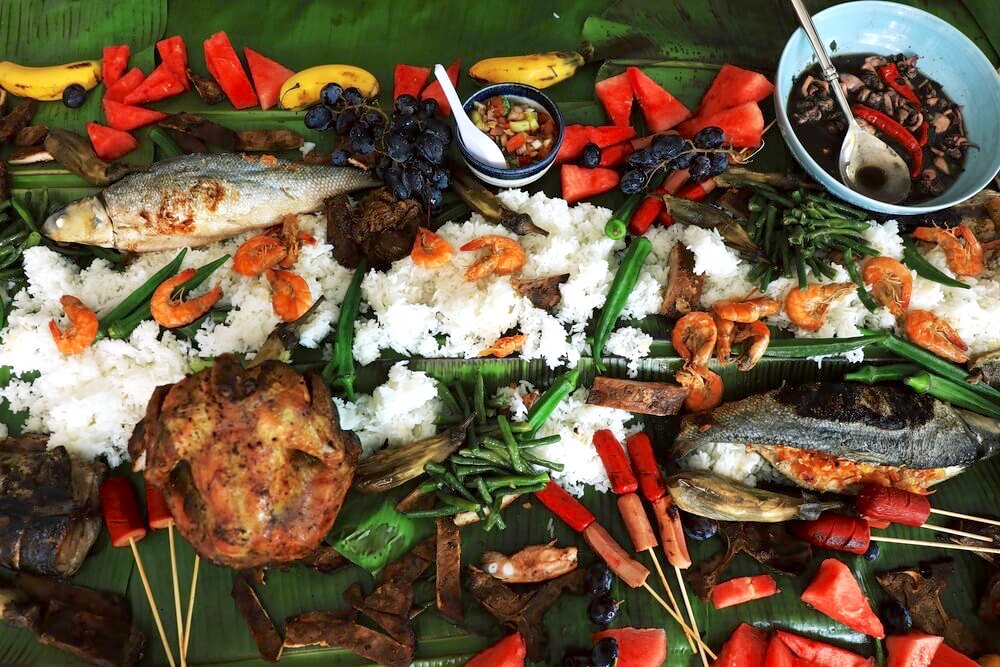Just about every country around the world will have their own “rules” when it comes to local customs and cultural etiquette. If you want to be accepted by the locals and really make the most of your trip, it always pays to acquaint yourself with these rules before traveling.
Planning a trip to the Philippines?
Here are ten cultural etiquette tips that you should know…
Pay Attention to Non-Verbal Communication
Non-verbal communication is huge in the Philippines.
This can be incredibly subtle, making this non-verbal language difficult for a tourist to pick up on unless they know exactly what they should be looking out for.
Here are a few examples of popular non-verbal gestures in the Philippines:
- A raised eyebrow – this usually means “yes”
- A head jerked downwards – this often means “no”
- A lift of the head or an eyebrow flash – this is a common form of greeting
- An open mouth – this is often a sign that a question has not been understood
- Raised ring and pinkie fingers – this is to indicate that there are two of something
Wondering if there is anything you shouldn’t do when it comes to non-verbal communication?
Yes, with one example being moving your index finger back and forth to beckon someone. This is considered to be extremely insulting.
Excessive eye contact and staring is also very rude, as is tapping someone on the shoulder.
Try to avoid standing around with your hands on your hips too, as this will make the locals think that you are angry. As you will find out further down, public displays of anger are something you need to avoid at all costs in the Philippines.
Be Punctual
Things can get a little confusing when it comes to punctuality in the Philippines.
In general, Filipinos tend to be quite relaxed about time-keeping, but this rule doesn’t apply to foreigners.
As a tourist, you are expected to always be punctual for events and gatherings.

However, if you have been invited to a meal at someone’s house, it would be acceptable to show up up to 30 minutes after the set time. Any later than this would be rude.
Always Greet Seniors First
If you ever greet a group of people in the Philippines, it is always important to greet the most senior person first.
This is a big sign of respect in the country, so make this a tip that you remember.
If the person you are greeting hasn’t yet given you permission to use their first name, then use their title, followed by their surname.
Wondering if you need to bow when greeting a senior?
It isn’t required, but you can if you want. If you decide to, follow these steps:
- Do a slight bow towards the elderly person
- Take their opposing hand and place it onto your forehead
This is referred to as Mano, and is a popular ritual in the Philippines.
Keep Your Handshake Soft
If you come from a Western country, then you are likely aware of how important it is to have a firm and strong handshake. After all, this is a sign of confidence!
However, this is not the case in the Philippines…
A strong handshake will often be viewed as a sign of aggression.
Instead, keep your handshake relaxed, soft, and limp.

If you are a man and are greeting a woman, wait for her to extend her hand first rather than initiating the handshake yourself.
Are you someone that doesn’t often shake hands?
You will likely end up doing so quite a bit in the Philippines. Handshakes are used frequently, not only when greeting people but also when saying goodbye.
Read Up on Local Terms and Phrases
Every country will have their own unique terms and phrases that often confuse tourists.
It is always a good idea to be well-versed with these beforehand. This will save you quite a bit of confusion while you are actually traveling!
Here are some phrases worth knowing when visiting the Philippines:
- I’ll go ahead – this is a term that often confuses tourists, but is simply what a Filipino will say when they want to leave a social gathering before other people
- C.R. or Comfort Room – this is the word for restroom, so don’t be confused if you see C.R on a door
- Hostess – while this just means a female host in Western countries, hostess in the Philippines means prostitute, so make sure that you never call your female host this!
- Tomboy – this word is usually used to refer to lesbians
- Jeep – this refers to the local jeepney, which are a form of public transport in the Philippines
- Tricycle – this is another form of public transport, this time a motorbike that has been attached to a sidecar which can usually hold up to five people
Gift-Giving
Been invited to a local Filipino home for a meal?
That’s a fantastic way to really immerse yourself in local life, but there are a few tips that you need to know first.
As mentioned above, make sure that you do not refer to your female host as a hostess!
Other than that, you will need to bring a small gift with you when visiting a local’s home.
What gift should you bring?
A small box of chocolates or sweets will always be well-received. Just like in Western countries, flowers are another acceptable gift, but avoid purchasing white lilies or chrysanthemums.
https://www.instagram.com/p/BuCpWFUgzsx/
Fruit baskets are also popular as a thank you gift, but make sure that you only send this after the event, rather than taking it with you.
Why?
Because this can be interpreted as a rude gesture by your host, as though you are saying that there will not be enough food at the event itself.
Whichever gift you choose to bring, make sure that it has been wrapped in an elegant way. Presentation is important when it comes to gift-giving in the Philippines.
Don’t expect your hosts to open their gift immediately either, as they will usually wait until later on to do this.
Keep Your Clothing Modest
Compared to some other Asian countries, the Philippines is quite relaxed when it comes to clothing. It is perfectly safe to walk around in shorts and a t-shirt, especially in the cities.
However, be wary when wearing anything less than this…
Yes, the country can get quite hot, but save your bikinis for the beach only. Even if you are staying at a beach resort, make sure that you cover up once you leave the beach or pool area.

Thinking of whipping off your bikini top for some topless sunbathing?
This is something that locals will very rarely do. While it isn’t necessarily frowned upon, especially in busy tourist resorts, be warned that you may end up attracting a crowd of gawking onlookers.
Of course, some parts of the country do have quite a large Muslim population. If you plan on traveling through those, or visiting any cultural sites, then you may need a more modest outfit.
Dining Etiquette
It can sometimes be quite difficult to navigate dining etiquette in a new country, but it is relatively simple in the Philippines.
When you are dining out at a restaurant with a group of people, be prepared for sharing-style dishes. Meals are a social experience in the Philippines, so there is usually plenty of food, along with plenty of conversation.
While guests are expected to eat heartily, you also don’t want to be the first person that helps themselves to the food, as this can be considered rude.
Your meals will likely consist of a main dish featuring meat or seafood, along with rice, vegetables and soup. Your hosts will always offer you more food, and, even if you are still hungry, you should say no the first time. Your host will then ask again, after which you say no again. Then, after the third time you have been asked, you can then take some more food.
What do you do if you really don’t want any more food?
You take a small amount and then leave this on your plate. In the Philippines, it is considered polite to leave a small amount of food behind on your plate, as this is a sign that your host has fed you well.
Wondering if the same applies to drinks?
In a way…
Whenever your glass is less than half full, it will likely be refilled. However, you should never refill your glass yourself. Instead, fill the glass of the person sitting next to you, and then he or she will fill yours.
Want to know if they use Western cutlery in the Philippines?
Yes, but usually just a fork and spoon, with the majority of the food being eaten off the spoon.
Of course, eating with the hands is common throughout the Philippines.
This can be tricky, especially with rice. Fortunately, there is a technique to this, which goes as follows:
- Reach into the dish of rice and take a small amount in your hands
- Use your middle and index fingers, as well as your thumb, to roll this into a ball shape. Make sure that you do not use the palm of your hand for this
- Dip this ball into the sauce provided
- Mix the ball of rice and sauce with one of the other dishes, be it vegetables, meat or anything else
- Then, eat!

Make sure that you use your right hand when eating with your hands, keeping your left hand placed on the table. Many Muslim traditions are still going strong in the Philippines, with one of them being that the left hand is considered to be unclean. You should also never use your left hand to pass food around the table.
Can’t seem to get the hang of eating with your hands?
It’s alright to ask for cutlery, especially since you are a visitor. Dining establishments will always try to accommodate their guests as much as possible.
Finally, no matter where you have been eating, make sure that you thank your host for the food that you have eaten after the end of your meal. Of course, this would be considered polite in just about every culture!
Yes Doesn’t Mean Yes
Filipinos hate to say a direct no to someone, as this is considered to be rude.
So, what do they say if they need to say no?
They will often still say yes, or will sometimes opt for a maybe.
This can often confuse visitors, so just remember that yes doesn’t necessarily mean yes.
As mentioned earlier, pay attention to non-verbal communication too…
If a Filipino says yes, but also jerks their head downwards, then this likely actually means no.
Don’t Raise Your Voice or Lose Your Temper
While the majority of Filipinos tend to be quite open with their emotions, it is considered extremely rude to display anger, especially in public.
If someone does lose their temper, the person who is being targeted will often not be able to defend themselves, for fear of being thought of as rude. It is also believed to bring shame to the person’s family.
Complaining is also a big no-no, even if you feel as though you are well within your rights to complain.
Instead, try to keep things as harmonious as possible.
Yes, this can be difficult when faced with everything from heavy city traffic to long delays with public transport, but this is all part and parcel of life in the Philippines.
Need to resolve a problem?
You can do this quietly and patiently, especially when there are other people around.
The Philippines is such a beautiful country to visit, and its culture is such a fascinating one. In order to ensure that your adventure in the Philippines goes as smoothly as possible, make sure that you keep these ten cultural etiquette tips in mind while traveling through the country.

Leave A Comment